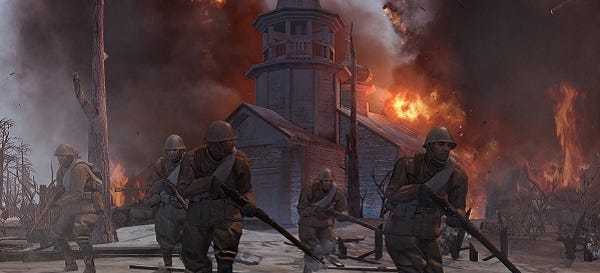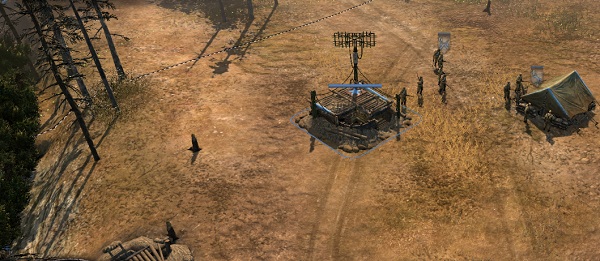Wot I Think: Company Of Heroes 2 Single Player
The Cold and the Dutiful
The Western Front isn't as quiet as you may have heard from other sources but the Eastern Front is almost certainly a great deal louder. That's what Company of Heroes 2 would have you believe at any rate, with a flashy new engine and a great deal of clamour presenting its conflict. But does the long-awaited sequel add anything more than enormous flurries and drifts of snow? I donned my thermal underpants and went to war.
For the first hour, Company of Heroes 2’s campaign threatens to be all sound and no strategy, fury without thought. It’s quite comfortably among the loudest strategy games in existence. The soothing click-click of the mouse is drowned out by the death rattle of machine guns and the occasional whirr of a brain cog is lost in the audible violence as the Eastern Front repeatedly explodes.
Given the setting, the constant barrage of noise makes sense. The number of men dying on both sides of the conflict is terrifying, and the focal points of each map are soon clogged with bodies and the smoking ruins of machines. It’s hard to spot the company of heroes among the legions of anonymous dead and doomed, although the cutscenes, which provide a post-war reflection on the horror and guilt of the survivor, are often strong. The sheer visual splendour of combat and the might of the engine can make war a thing to goggle at, players peering at the screen like dogs on the wrong side of a butcher’s window, but it’s a grimy sort of spectacle. Zoom in close and the grisliness of the scene is more apparent – explosions make meat of soldiers, and the dying crawl and stagger.
The constant stream of allies and enemies pouring across many of the campaign maps, the planes and mortars shrieking overhead, and the battles occurring at the periphery all contribute to the sense of a larger conflict. The sense of engaging in a skirmish or defensive action that is only part of an incomprehensible whole is as convincing as I’ve ever seen, sometimes distractingly so. There are times during the campaign when Company of Heroes 2 is so determined to show the scale and set pieces of war that the player takes the role of spectator, following the occasional signpost and using or collecting equipment as and when a commander swearily barks instructions.
All of this combined to make my first impressions underwhelming. I actually scribbled ‘Call of Duty RTS’ on a piece of paper after following another arrow to another target and realising, once again, that constant reinforcements meant there was no danger or risk. More men for the meatgrinder and no reason to care for the consequences.
The menu didn’t help. I debated whether or not it was worth writing a short paragraph about a bloody menu, but here I am, writing that paragraph. It looks more like a digital storefront than an actual game, advertising its (cosmetic) wares, double experience events and broadcasting possibilities. It’s cluttered and wants me to upload my failures and successes, or to paint a tank, or to preorder something or other. I feel like it’s shouting at me.
None of that, even the XP and DLC stuff, has much of an effect on the game. I haven't bought anything but have unlocked unit abilities and decorations for use in skirmish by playing the campaign and against the AI in the Theatre of War mode. As with the sound of my brain-cogs during a war, the Theatre of War is easy to miss among the noise and mess of the menu. Comprising singleplayer, co-op and competitive scenarios, it’s where the game shines brightest. Pick a battle, either as the Soviets or the Germans, and master a map. It’s a much more direct model of the slow-burn take on RTS that the original game and its add-ons excelled at and it’s tempting to say that it avoids the excess of the campaign, but that’s not entirely true. Instead, it escalates toward it, beginning with basic base construction, more flexible than in COH 1, and expanding into a miniature arms race. You bring tanks, I’ll plant mines and force you onto the ice, or cripple their tracks. You counter with an infantry rush and I’ll be waiting with machine gun killzones at the ready.
On the whole, the pace of the game is as splendidly pitched as ever, allowing room to think and to counter, but never lacking tension. Even against the AI, which is how I’ve spent the vast majority of my time with the game, the ideal next move is often read as much in the actions of the enemy as in the layout of the battlefield. It’s often impossible to know the best route, either through the tech/construction tree or across the map, without at least trying to predict where the next attack is coming from, or what shape it will take. On one level, it’s actual war as a giant tug of war, a back and forth for control of resources and choke points, but it’s also very much like playing with the most incredible box of toy soldiers ever.
The simplicity of movement is a huge part of the game’s tactical appeal. While sometimes muddling around cover rather than sticking to it, when squads do accurately follow instructions, they can be made safe, hunkered down under fire, until their opponents try to flank them or bring in heavier weaponry. Brilliantly, this means that the passage of time itself doesn’t force the player to take action, but the movements and menace of an enemy eventually will. Unless the weather is playing its part, in which case immobility can be death.
During snowstorms, mobility and visibility are reduced, and engineers must start fires to keep troops alive. This, along with the breaking ice that can be the end of a tank or a trooper, may not seem like a huge addition, but as well as being so well realised that I actually feel cold when my men are shivering through them, the snow-laden maps change tactical approaches enormously. In a game so strongly defined by its pacing, the change to unit speed, and the need to react to alter approaches to positioning and construction , have a significant impact on strategies.
The campaign, despite telling its story well, is something of a disappointment, partly because it is so intent on telling its story. With the superb weather effects, a dynamic struggle for territory, taking in the changing seasons, would have been excellent, if unhistorical, and the later stages of the campaign do feature some superb, long-form battles. In multiplayer and against the impressive - if eventually predictable – AI, the technical improvements, such as the much improved line of sight calculations and increased environmental destruction, create alternate tactics.
Ambushes are a much more effective option, particularly when faced with vehicles, which react magnificently to damage, both in terms of losing function and jolting with punchy physicality. The Soviets are also dab hands at requisitioning evacuated vehicles and abandoned weapons, which creates further tension when deploying units. Bring a gun (tank) to a knife (gun) fight and you might find it turned against you.
RTS games often apply pressure as soon as the map is loaded – it’s like being trapped in that sodding garbage compactor – but Company of Heroes is more like fencing or playing chess than bench-pressing. And that’s why this sequel, though a long time coming and slow to find its stride, is a success. It is more of the same, yes, but it still feels different to every other RTS out there. I wanted more of an individual focus, Men of War blustering into my imagination as it so often does, but COH 2 has its own approach, blending small-scale tactical positioning with larger strategic movements and decisions.
I suspect some will be dismayed by how similar the game is to the original and it’s fair to say that it doesn’t feel as fresh or vital. Company of Heroes hasn’t been reduced by the passage of time though, continuing to stand out in its wartorn corner of the strategy square dance. The new engine is spectacular but the visual splendour does threaten to overwhelm the meat of the game, particularly in the campaign’s more explosive moments. Scrape all of the snow and smoke away, however, and something would be lost because the technology does add to the decision-making in more subtle ways than might be imagined. Company of Heroes 2 is a deceptively noisy and violent game that is actually designed for those with slow hands, quick wits and flexible thought processes.
It really does have a rubbish menu screen though.
Company of Heroes 2 is out on June 25th.





